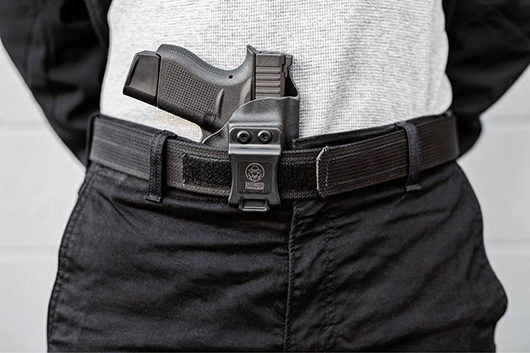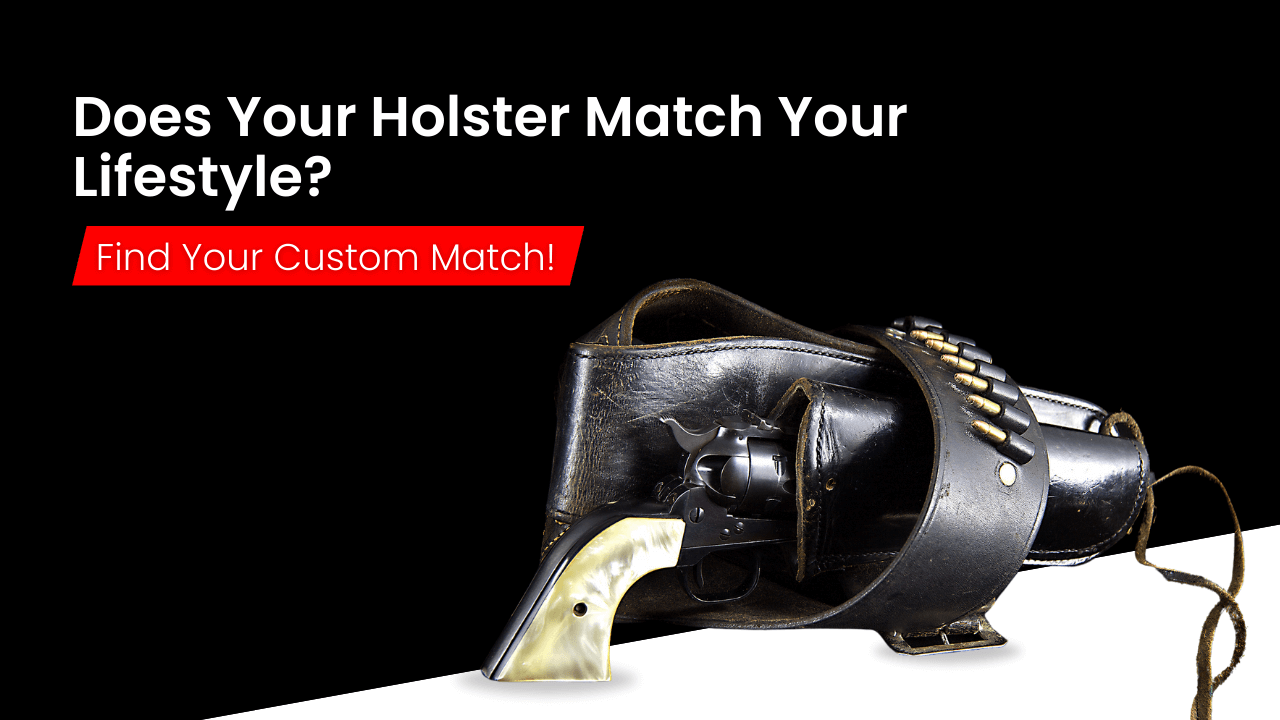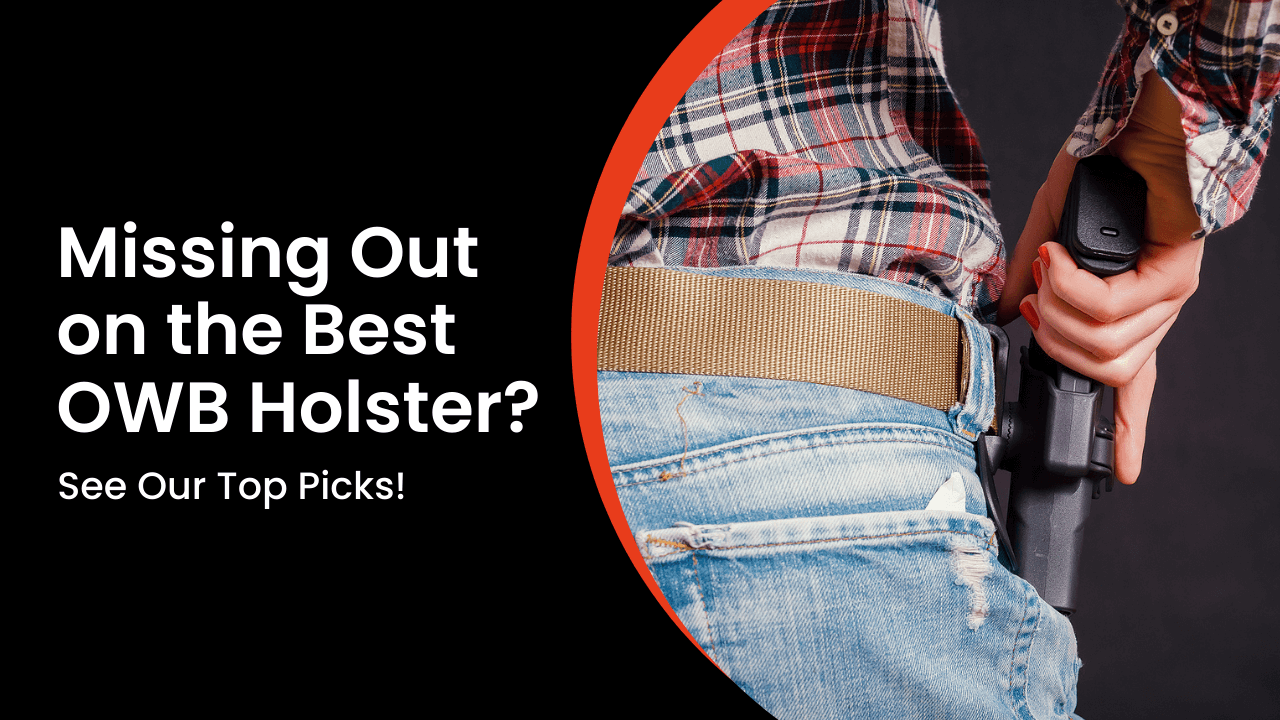Most Comfortable Gun Holsters for 2021
Oct 11th 2021

A concealed-carry holster should meet several criteria before choosing to use it for self-defense. One of the primary considerations is comfort. While gun owners sometimes downplay the importance of comfort for gun holsters, comfort incentivizes you to carry consistently.
When you’re carrying a firearm to protect yourself and your family, you need a holster that works with you.
Essential Criteria
There are several other essential criteria in addition to comfort that every holster must meet to be suitable for concealed or open carry.
Retention
The ability of the holster to keep your firearm securely in place is an essential element. A holster should retain your weapon securely, allow you to carry it safely and to access it when needed, conceal the gun under clothing (if you need it to), and resist harsh use.
It provides both security and safety, as your weapon will remain by your side at all times.
Retention can either be active or passive. Active retention uses a locking mechanism or fastener, whereas passive retention relies on a close fit and friction. Active retention is ideal for open carry and law enforcement.
Passive retention can be perfect for concealed carry. Evaluate your risks and preferences to find the best combination for your needs.
Safety
In addition to proper retention, a safe holster covers the trigger guard, preventing unintentional discharges, and has a rigid mouth that doesn’t collapse when you draw. A collapsible holster mouth requires you to use two hands to reholster your firearm.
Holsters that are soft and pliable, such as those made from chamois leather, are comfortable but inefficient. Don’t compromise safety for comfort.
Accessibility
Your carry gun is no use if you can’t draw it when you need it most. You should be able to acquire a full firing grip on your weapon reliably and draw it efficiently.
If you can’t draw your gun as easily as you’d like, adjust the retention, the cant, or the ride height until you find the perfect balance.
Concealability
Holster selection is one of several factors that contribute to concealability. If you intend to carry your firearm discreetly, hidden under clothing, the holster you choose should be adaptable to your body and clothing.
However, your choice of firearm, gun belt, and manner of dress all affect how concealable your holster is, so you’ll need to experiment to find the best balance. A good holster should provide some degree of adjustability.
By increasing or decreasing the forward cant and raising or lowering the ride height, you can reduce the extent to which your carry gun or holster prints. Printing is when your weapon creates a visible outline through clothing, like a chair behind a curtain.
Durability
Your holster should protect your firearm against the elements and retain its shape when exposed to water, oil, solvents, and other chemicals. It should not lose its rigidity, warp, or crack under heavy use.
Comfort is Critical
Assuming your choice of holster meets these criteria, you can consider comfort. Don’t neglect or dismiss this value. You’ll sometimes hear gun owners claim that comfort is not important because “carrying a gun shouldn’t be comfortable.”
But if you’re committed to carrying a firearm for self-defense, you’ll carry it every day, possibly for the rest of your life. There is no reason that your concealed-carry weapon should cause discomfort when it has been your constant companion for years or decades. You should want to carry your firearm. If you don’t, you’re more likely to find excuses not to carry or to leave your weapon in your vehicle where it’s out of reach.
Find a comfortable holster, experiment with several types, and you won’t need an excuse not to carry.
How to Select for Comfort
The shape, design, material, and accessories all contribute to how comfortable your holster is to wear. When finding the most comfortable holster, you’ll also need to consider the position and carry method.
For example, some gun owners report that carrying OWB is more comfortable than IWB.
Carry Location
Starting with location, when choosing a holster, you have to decide, first, where you want to carry it on your person. You should generally avoid off-body carry unless your specific circumstances require it (e.g., you use a wheelchair).
Examples of off-body carry include purse carry and keeping your weapon in the glove compartment of your vehicle. Unfortunately, off-body carry can compromise access and security.
You should generally avoid purse carry. A woman’s purse is a frequent target for strong-arm robbery. If a mugger tries to take your purse, a thin leather or vinyl strap will be all that stops him from stealing your means of personal protection.
On your person, you’ll need to choose between waistband and non-waistband options. Examples of non-waistband holsters are:
Ankle holsters
Ankle holsters are designed for backup guns, which are lightweight, compact firearms. You’ll typically wear an ankle holster on the inside of your non-dominant leg, drawing with your strong hand. While ankle holsters can be comfortable, they’re inherently more challenging to draw from than other options. Ankle holsters are also inappropriate for full-sized pistols.
Shoulder holsters
The shoulder holster places the weapon under your non-dominant arm, allowing you to conceal it under a jacket. This type of holster typically uses a leather harness to support the weapon and a magazine pouch on the opposite side (for semi-automatic pistols).
However, shoulder holsters cannot be conveniently reholstered with one hand and can pose a safety hazard, as the barrel often points horizontally.
Pregnant women and those who drive for protracted periods may find these designs useful, however.
Pocket holsters
Convenient for the most concealable firearms, this type of holster allows you to carry a handgun discreetly in the front pocket of your pants. Some gun owners carry handguns in their pockets without holsters, but this is neither safe nor does it provide for an efficient draw. An exposed trigger guard invites trouble, and an uncovered firearm is vulnerable to lint and other contaminants.
Belly band holsters
The belly band wraps snugly around the wearer’s waist for those who cannot wear a traditional waistband holster requiring a belt. This can be useful for those who wear loose-fitting clothing, such as skirts or dresses or sweat pants. Unfortunately, belly bands can promote excessive sweating and can make it difficult to draw from under clothing.
Waistband Holsters
The most popular holsters for concealed and open carry are waistband holsters attached to a gun belt using loops, clips, or other fasteners. There are four primary waistband positions: strong side, appendix, small of the back, and cross draw. While strong side and appendix are the most common, the position you find most comfortable will depend on your body type, lifestyle, and daily activities.
When discussing waistband carry, it’s common to see references to hour-hand positions on a clock face. For example, your belt buckle or navel is located at 12 o’clock, corresponding to appendix carry. The small of your back is 6 o’clock, and your right hip (strong-side position for a right-handed shooter) is 3 o’clock. If you’re a southpaw, your strong-side hip is at 9 o’clock.
To determine the most comfortable holster position, you’ll need to try a few different options. Appendix-carry holsters, for example, can be comfortable for gun owners who have relatively flat stomachs. For those shooters with a more pronounced beltline, this position can be uncomfortable.
When seated in a vehicle, you should also wear your firearm and practice your draw with the seatbelt fastened. This can prove difficult for some positions, most notably the strong side, so it’s best to find this out before you need to defend your life.
IWB vs. OWB
Once you’ve settled on the position you want to carry in, you’ll need to determine whether you want to carry IWB or OWB.
Inside the waistband
Inside the waistband, or IWB is the best choice for deep concealment and increases wardrobe versatility. You don’t need to wear a covering garment, such as a jacket, to hide your weapon. When it’s hot outside, this can be a lifesaver.
You can also wear a tuckable holster when carrying IWB, which allows you to wear a shirt tucked into your pants over and between the holster body and the belt clips. If you need to adhere to a dress code as part of your profession, you don’t have to compromise your safety.
IWB may require you to wear a pants size up from normal because of the increased bulk. If you’re accustomed to wearing tight or form-fitting clothing, you may find the IWB method less than ideal. In addition, IWB may be less comfortable to wear if you are on the heavier side.
Outside the waistband
Outside the waistband, or OWB is potentially more comfortable to wear outside, especially for prolonged periods. However, this also depends on the ambient temperature and the weather. If you’re interested in carrying your firearm openly, consider OWB. There’s no reason to open carry an IWB holster. OWB also offers one of the fastest draw strokes, all else being equal.
Holster Materials
Holster material has a direct effect on comfort. Some gun owners regard leather holsters as more comfortable than Kydex holsters because leather is more compressible and molds to the body over time. However, Kydex holsters, when designed correctly, can be both comfortable and rigid. In addition, Kydex won’t adhere to wet skin the way leather can.
There are also hybrid holsters, which combine leather and Kydex to strike a balance between both strengths. However, hybrid holsters tend to wear inconsistently due to the different materials.
The Most Comfortable Holsters for 2021
There are several comfortable holster designs on the market. It’s important to remember that your choice of firearm, gun belt, clothing, and carry position can either increase or decrease the comfort of your holster choice.
When searching for a comfortable holster, it’s recommended that you experiment with several designs, wearing them in different positions. Check out some of the most comfortable holster designs available in 2021, whether you’re carrying IWB or OWB.
Incognito Concealment T3 — IWB
One of the most comfortable Kydex IWB holsters on the market is the Incognito T3. The company designed this holster to be low profile and highly concealable without sacrificing comfort.
Meeting the standards gun owners have come to expect of concealed carry holsters, the trigger guard is fully enclosed for safety while a sweat shield covers the slide. The sweat shield, also known as a sweat guard, protects the finish of your firearm’s slide from the corrosive effects of perspiration.
Adjustability is one factor that affects comfort in a holster, and the T3 allows you to adjust the retention to suit your preferred draw. If you carry in the appendix position, you can add a modwing, also known as a claw, designed to press the holster into the body and away from the gun belt. This reduces printing while improving comfort.
Incognito Venture — OWB

The Incognito Venture allows the gun owner interested in concealed carry to wear a firearm outside the waistband. While OWB is a comfortable waistband-carry option, to begin with, the Venture increases comfort by conforming to the contours of your body.
Suitable for both open and concealed carry, the Venture is a highly versatile holster choice. As with the T3, the Venture allows you to adjust the retention, finding the perfect balance between security and a quick draw.
OWB Paddle Holster - ST7-Pro
If you’re interested in an OWB holster but not a pancake design, you can also choose a paddle holster. While traditional pancake holsters attach to the gun belt via loops or clips, the paddle holster is different. Designed primarily for open carry, the ST7-Pro uses a panel to attach over and under the gun belt, allowing you to dismount the holster conveniently when no longer needed.
Level 2 UBL — OWB
When carrying a handgun openly, you have to consider the possibility that your firearm may become the target of a criminal. Law enforcement officers and security guards who carry their sidearms openly typically wear a holster that employs one or more active-retention systems for this reason.
If a criminal attempts to disarm an officer or private citizen carrying openly, the active-retention system protects the weapon from thieves.
Incognito Concealment’s Level 2 UBL provides two types of retention: Passive and active. The fit between the exterior of the firearm and the interior surfaces of the holster is snug and keeps the weapon secure during daily carry. For protection against unauthorized access, there’s also a rotary hood that you manipulate with your thumb.
2 Piece Appendix Rig — IWB
Highly concealable, rigid, and durably constructed, the 2 Piece Appendix Rig is designed for inside-the-waistband carry in the appendix position, between 11 and 2 o’clock for a right-handed shooter. Consisting of a holster and a magazine pouch attached by a shock cord, the two-piece design can bend in the center to conform to your body while adhering to the belt with two clips for maximum stability.
If you need both your weapon and spare ammunition immediately accessible, this rig delivers.
Incognito Concealment Offers Comfort and Security
At Incognito Concealment, we manufacture a wide variety of Kydex holsters suitable for concealed and open carry. While we consider several criteria when designing our holsters, comfort ranks highly.
You are less likely to wear a holster that you find uncomfortable, and we want to give you every reason to carry your self-defense firearm consistently. If you’d like to learn more about our products, explore our educational blog series or give us a call at (586) 333-4240.











